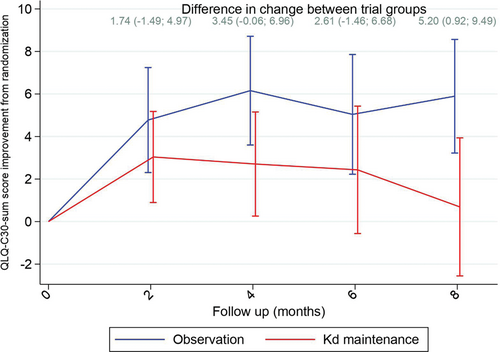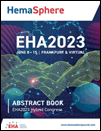P1671: CARFILZOMIB-DEXAMETHASONE MAINTENANCE HAMPERS RECOVERY AFTER SALVAGE AUTOLOGOUS STEM CELL TRANSPLANTATION IN PATIENTS WITH MULTIPLE MYELOMA
Abstract Topic: 35. Quality of life and palliative care
Background: Health-related quality of life (HRQL) outcomes are important secondary endpoints in cancer trials, especially in long-term therapy. Decisions regarding long-term therapy must be considered individually based on evidence-based knowledge of treatment efficacy and HRQL-related consequences. In the CARFI trial, patients with multiple myeloma in first relapse underwent Carfilzomib-cyclophosphamide-dexamethasone induction followed by salvage autologous stem cell transplantation (sASCT) before randomization to Carfilzomib-dexamethasone (Kd) maintenance therapy or observation. The primary trial endpoint was time to disease progression, which was significantly extended by 8 months for patients allocated to Kd maintenance (Gregersen H et al. Eur J Haematol. 2022;108(1):34-44). Here, we report the pre-specified primary and secondary HRQL endpoints of the CARFI trial.
Aims: The primary HRQL endpoint was effect of Kd maintenance therapy, relative to observation, assessed by EORTC QLQ-C30 Summary (QLQ-C30-sum) score at 8 months follow-up. The secondary HRQL endpoint was change in the individual HRQL domain scores at 8 months follow-up.
Methods: HRQL was assessed with the cancer specific questionnaire EORTC QLQ-C30, the myeloma specific module EORTC MY20 and the FACT/GOG-Ntx for assessing peripheral neuropathy at randomization and every second month during follow-up. HRQL data were analysed with linear mixed models for repeated measures. The threshold for statistical significance was set at p<0.05 for the primary HRQL endpoint, and a between-group minimal important difference (MID) of 10 points was interpreted as clinically relevant for the QLQ-C30-sum score. Individual domain scores were evaluated for statistically significant change (p<0.01), with clinical significance determined relative to small evidence-based thresholds for MID.
Results: In total, 168 patients from Norway, Denmark, Sweden, Lithuania and Finland were randomised. 82 patients were allocated to Kd maintenance and 86 patients to observation. Median age for the Kd group was 60 years (IQR 54-65) and 63 years for the observation group (IQR 58-67). Median time from sASCT to randomization was 8.1 weeks for both groups. Overall questionnaire completion rate was 93%. For the QLQ-C30-sum score at 8 months follow-up, the mean difference between the Kd group and the observation group was statistically significant (5.20, 95% CI 0.92 to 9.49, p=0.017) but not clinically relevant (Figure 1). In the individual domain score analyses, the patients in the observation group reported statistical significantly and clinically meaningful improvements in physical, role, and social functioning as well as reduced fatigue, appetite loss and body image at 8 months, which was not the case for the Kd maintenance group.
Summary/Conclusion: Although Kd maintenance extended progression-free survival by 8 months, it also hampered recovery after sASCT in three functioning domains and prolonged the period with appetite loss, fatigue and affected body image. In clinical decision making, the negative impact on quality of life aspects should be balanced against the improved progression-free survival obtained by Kd maintenance therapy.
Keywords: Maintenance, Quality of life, Randomized, Multiple myeloma





